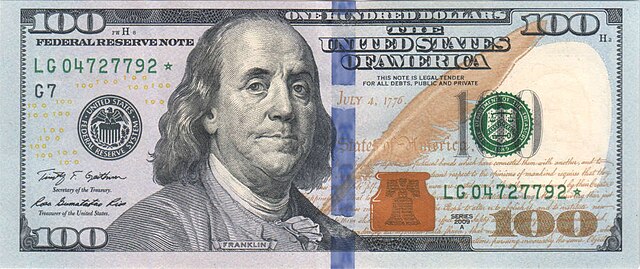100
Natural number From Wikipedia, the free encyclopedia
Natural number From Wikipedia, the free encyclopedia
100 or one hundred (Roman numeral: C)[1] is the natural number following 99 and preceding 101.
| ||||
|---|---|---|---|---|
| Cardinal | one hundred | |||
| Ordinal | 100th (one hundredth) | |||
| Factorization | 22 × 52 | |||
| Divisors | 1, 2, 4, 5, 10, 20, 25, 50, 100 | |||
| Greek numeral | Ρ´ | |||
| Roman numeral | C, c | |||
| Binary | 11001002 | |||
| Ternary | 102013 | |||
| Senary | 2446 | |||
| Octal | 1448 | |||
| Duodecimal | 8412 | |||
| Hexadecimal | 6416 | |||
| Greek numeral | ρ | |||
| Arabic | ١٠٠ | |||
| Bengali | ১০০ | |||
| Chinese numeral | 佰,百 | |||
| Devanagari | १०० | |||
| Hebrew | ק | |||
| Khmer | ១០០ | |||
| Armenian | Ճ | |||
| Tamil | ௱, க௦௦ | |||
| Thai | ๑๐๐ | |||
| Egyptian hieroglyph | 𓍢 | |||
| Babylonian cuneiform | 𒐕𒐏 | |||

100 is the square of 10 (in scientific notation it is written as 102). The standard SI prefix for a hundred is "hecto-".
100 is the basis of percentages (per centum meaning "by the hundred" in Latin), with 100% being a full amount.
100 is a Harshad number in decimal, and also in base-four, a base in-which it is also a self-descriptive number.[2][3]
100 is the sum of the first nine prime numbers, from 2 through 23.[4] It is also divisible by the number of primes below it, 25.[5]
100 cannot be expressed as the difference between any integer and the total of coprimes below it, making it a noncototient.[6]
100 has a reduced totient of 20, and an Euler totient of 40.[7][8] A totient value of 100 is obtained from four numbers: 101, 125, 202, and 250.
100 can be expressed as a sum of some of its divisors, making it a semiperfect number.[9] The geometric mean of its nine divisors is 10.
100 is the sum of the cubes of the first four positive integers (100 = 13 + 23 + 33 + 43).[10] This is related by Nicomachus's theorem to the fact that 100 also equals the square of the sum of the first four positive integers: 100 = 102 = (1 + 2 + 3 + 4)2.[11]
100 = 26 + 62, thus 100 is the seventh Leyland number.[12] 100 is also the seventeenth Erdős–Woods number, and the fourth 18-gonal number.[13][14]
The 100th prime number is 541, which returns for the Mertens function.[15] It is the 10th star number[16] (whose digit sum also adds to 10 in decimal).
There are exactly 100 prime numbers in base-ten whose digits are in strictly ascending order (e.g. 239, 2357, etc.).[17] The last such prime number is 23456789, which contains eight consecutive integers as digits.
One hundred is the atomic number of fermium, an actinide, and the last of the heavy metals that can be created through neutron bombardment.
On the Celsius scale, 100 degrees is the boiling temperature of pure water at sea level.
The Kármán line lies at an altitude of 100 kilometres (62 mi) above the Earth's sea level and is commonly used to define the boundary between Earth's atmosphere and outer space.

Most of the world's currencies are divided into 100 subunits; for example, one euro is one hundred cents and one pound sterling is one hundred pence.
By specification, 100 euro notes feature a picture of a Rococo gateway on the obverse and a Baroque bridge on the reverse.

The U.S. hundred-dollar bill has Benjamin Franklin's portrait; the "Benjamin" is the largest U.S. bill in print. American savings bonds of $100 have Thomas Jefferson's portrait, while American $100 treasury bonds have Andrew Jackson's portrait.
One hundred is also:
Seamless Wikipedia browsing. On steroids.
Every time you click a link to Wikipedia, Wiktionary or Wikiquote in your browser's search results, it will show the modern Wikiwand interface.
Wikiwand extension is a five stars, simple, with minimum permission required to keep your browsing private, safe and transparent.